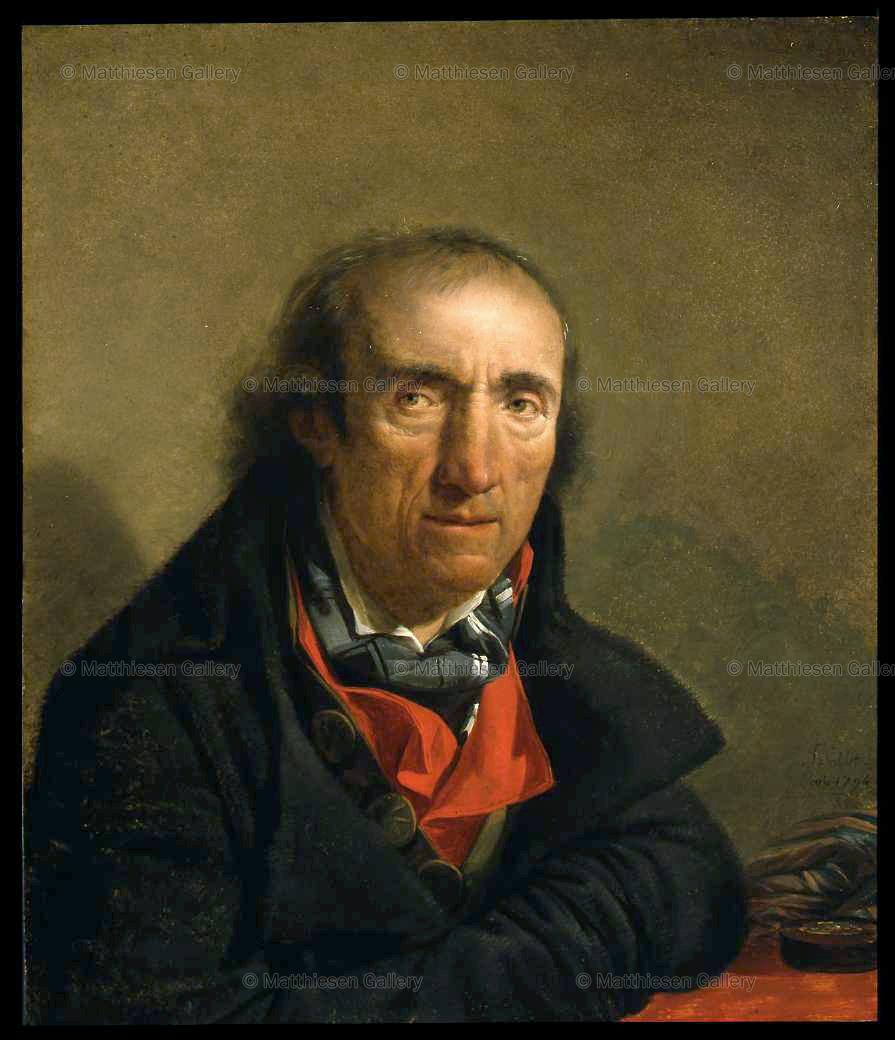Portrait of a Revolutionary(Jean Francois Sablet)
JEAN-FRANCOIS SABLET
1745-1819
Portrait of a Revolutionary
Signed, dated and inscribed: F.Sablet/ Paris 1794
Oil on panel; 64.5 x 54.9 cm (24 ¼ x 21 ¾ in)
Born in Morges, in Switzerland, the son of a painter and picture dealer, Jacob Sablet (17201798), Jean-François Sablet first trained with his father. In 1767, he entered the Paris Académie as a student of Joseph-Marie Vien, under whom his brother Jacques later studied as well. The brothers made their reputations in different genres: Jean-François (more commonly know as François) as a portraitist and Jacques as a history and genre painter. In his early career Francois excelled at landscape and occasionally painted genre scenes and even the odd mythological subjects. Jacques made a particular success of group portraiture and conversation pieces. This occasional cross-over between genres and the fact that Jacques was the more prolific and better known artist means that Francoiss work is often mis-attributed to his brother. However, the signature and approach to portraiture leaves no doubt that this forthright image of a venerable revolutionary is from Francoiss hand and this attribution has been confirmed by Anne Van de Sandt.
The as yet unidentified sitter for this portrait is depicted bust length, seated at a table draped in red upon which can be seen a wadded tricolore and a round box, possibly a compass. He wears a black overcoat of rough wool over a grey coat with large figured buttons, a red waistcoat and white shirt tied with a cravat striped in white and navy blue. If the object on the table is in fact a compass and the buttons carry insignia, these might possibly identify the sitter as a figure in the French navy, an institution which by 1974 had undergone devastating changes. In any case, the tricolore on the table at least identifies the subject as one sympathetic to the Revolution and its ideals. He is a man of evident age and gravitas and the former faith and determination, as well as the present fatigue and disillusionment such a man might feel by 1794, is eloquently transcribed across his careworn face in every wrinkle, sag and grizzled lock that Sablet has taken such pains to capture. The portrait in fact closely evokes the warts and all style of roman Republican portraiture, examples of which Sablet had no doubt seen during his brief period in Rome between 1791 and 1793. Another possibility is that he sitter was an officer of the local government at the Municipalité or at the Administration des Sections in the revolutionary government of the Convention.
Francois Sablet was an ardent supporter of the Revolution, as was his brother Jacques. In February of 1793, just days after France declared war on Britain, Holland and Spain, the brothers were forced to leave Rome, along with the rest of the French community residing there. The French architect Béat de Hennezel wrote: les Sablet son partis par l’ordre du gouvernement pour leur democratie & imprudences. The Sablets returned to France via Lausanne finally reaching Paris by October of 1793. The following year François was received as a member of the Revolutionary Commune des Arts, and exhibited in the Concours de l’an III (1794) though it not known whether he included the present portrait.
Among Françoiss Sablets earlier portraits are those of Charles de Bourbon, Comte dArtois, as Colonel General of the Swiss and Grison Guards (1774), which survives in a gouache on vellum study in Fribourg, the portrait of Charles-Henri, comte dEstaing, preserved in an engraving by Charles Gaucher, and a portrait of Jacques Sablet (Lausanne, Musée Cantonal des Beaux-Arts), painted just before his departure for Italy in 1775. In 1791 François finally left France to join Jacques in Rome. During this brief two year period François concentrated mainly on producing landscapes, and views of Roman ruins, several of which were later engraved by Francisco and Pietro Piranesi. He also made studies of the various local costumes of the Campagna.
After he was obliged to leave Rome with the rest of the French community, François became a member of the Revolutionary Commune des Arts and subsequently produced several portraits of Revolutionary figures and icons including Joseph-Agricol Viala, William Tell and Lycurgus, all of which were engraved by Pierre-Michel Alix. After the turn of the century, Francois spent most of his career in Nomandy. In 1805 he established himself in Nantes, producing small-scale likenesses of local notables, and several members of the Peccot and Crucy families, often rendered with brutal accuracy. Most of these portraits are conserved in the Musée Dobrée, Nantes. In 1812, François decorated the Bourse in Nantes with six large grisailles depicting the Visite de Napoléon à Nantes en 1808 that have since been sold in the United States, though the preparatory studies remain in the Musée Dobrée.

